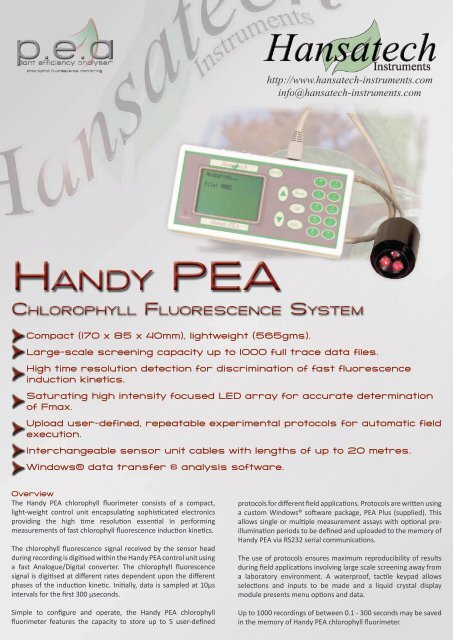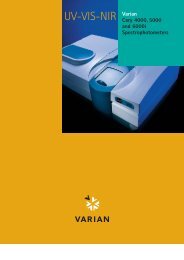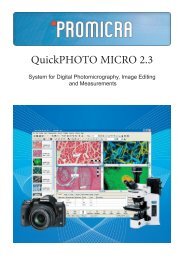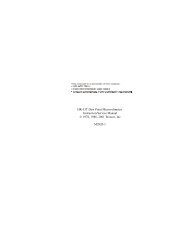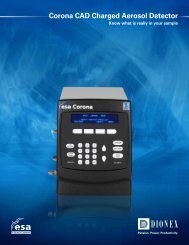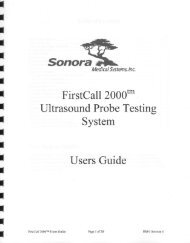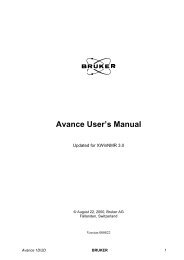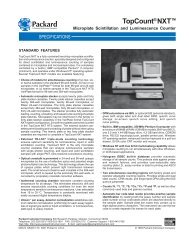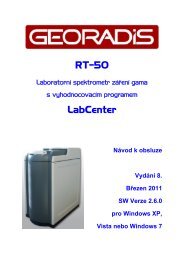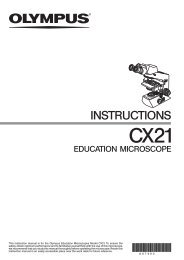Handy PEa Handy PEa - Hansatech Instruments Limited
Handy PEa Handy PEa - Hansatech Instruments Limited
Handy PEa Handy PEa - Hansatech Instruments Limited
Create successful ePaper yourself
Turn your PDF publications into a flip-book with our unique Google optimized e-Paper software.
http://www.hansatech-instruments.cominfo@hansatech-instruments.comHa n d y PEACh l o r o p h y l l Fl u o r e s c e n c e Sy s t e mCompact (170 x 85 x 40mm), lightweight (565gms).Large-scale screening capacity up to 1000 full trace data files.High time resolution detection for discrimination of fast fluorescenceinduction kinetics.Saturating high intensity focused LED array for accurate determinationof Fmax.Upload user-defined, repeatable experimental protocols for automatic fieldexecution.Interchangeable sensor unit cables with lengths of up to 20 metres.Windows® data transfer & analysis software.OverviewThe <strong>Handy</strong> PEA chlorophyll fluorimeter consists of a compact,light-weight control unit encapsulating sophisticated electronicsproviding the high time resolution essential in performingmeasurements of fast chlorophyll fluorescence induction kinetics.The chlorophyll fluorescence signal received by the sensor headduring recording is digitised within the <strong>Handy</strong> PEA control unit usinga fast Analogue/Digital converter. The chlorophyll fluorescencesignal is digitised at different rates dependent upon the differentphases of the induction kinetic. Initially, data is sampled at 10µsintervals for the first 300 µseconds.Simple to configure and operate, the <strong>Handy</strong> PEA chlorophyllfluorimeter features the capacity to store up to 5 user-definedprotocols for different field applications. Protocols are written usinga custom Windows® software package, PEA Plus (supplied). Thisallows single or multiple measurement assays with optional preilluminationperiods to be defined and uploaded to the memory of<strong>Handy</strong> PEA via RS232 serial communications.The use of protocols ensures maximum reproducibility of resultsduring field applications involving large scale screening away froma laboratory environment. A waterproof, tactile keypad allowsselections and inputs to be made and a liquid crystal displaymodule presents menu options and data.Up to 1000 recordings of between 0.1 - 300 seconds may be savedin the memory of <strong>Handy</strong> PEA chlorophyll fluorimeter.
Saved data may be viewed onscreen in numerical format withcalculated parameters or transferred to the PEA Plus softwarewhere it may be viewed graphically or exported to externalsoftware packages for further statistical analysis.The sensor unit consists of an array of 3 ultra-bright red LED’soptically filtered to a peak wavelength of 650 nm, which is readilyabsorbed by the chloroplasts of the leaf, at a maximum intensity of>3000 µmol m-2 s-1 at the sample surface. The LED’s are focusedvia lenses onto the leaf surface to provide even illumination overthe area of leaf exposed by the leafclip (4mm dia).LED’s have the advantageof being rugged, emittinglow levels of heat, andof rising to full intensityvery rapidly (typicallymicroseconds) after beingswitched on. This featureeliminates the inaccuraciesof Fo measurement and theconstraints on speed andreliability associated with a shutter which is a necessary item insystems using filament lamps rather than LED’s.An optical feedback circuit monitors and corrects changes inthe output intensity of the LED’s. These changes are caused byinternal heat build up in the LED’s. The circuit also compensatesfor intensity changes caused by variation in ambient temperature.The light source is calibrated before leaving the factory but maybe calibrated by the user at regular intervals using the SQS SerialQuantum Sensor.The detector is a high performance Pin photodiode and associatedamplifier circuit. The optical design and filtering ensure that itresponds maximally to the longer wavelength fluorescence signaland blocks the reflected shorter wavelength LED light used as thesource of illumination.The sensor unit is connected to the <strong>Handy</strong> PEA control unit via astandard connection cable of 1m in length however, connectioncables of up to 10m in length are also available on request.Leafclips and Sample Dark AdaptationThe first step in the measurement process is to cover the samplearea to be analysed, with a small, lightweight leafclip. The cliphas a small shutter plate which should be closed overthe leaf when the clip is attached so that light isexcluded and dark adaptation takes place. Thebody of the clips are constructed from whiteplastic to minimise the effects of heat build-upon the leaf during the period when the clip isin place. The locating ring section of the clipwhich interfaces with the fluorimeter opticalassembly is constructed from black plastic. Thisensures that the measurement is unaffected whenmeasuring during conditions of high ambient lightintensity.The leaf or needle rests on a foam pad whilst in the clip in orderto minimise damage to the structure of the leaf. The shutter plateshould be closed to exclude light from the sample during darkadaptation.During dark adaptation, all the reaction centres are fully oxidisedand available for photochemistry and any fluorescence yieldis quenched. This process takes a variable amount of time anddepends upon plant species, light history prior to the darktransition and whether or not the plant is stressed. Typically, 15 -20 minutes may be required to dark adapt effectively. In order toreduce waiting time before measurement, a number of leaves maybe dark adapted simultaneously using several leafclips. Some userseven make measurements at night, thus ensuring an adequatesupply of readily dark adapted samples and zero waiting time!PEA Plus SoftwarePEA Plus provides a comprehensivetool for in-depth analysis of datarecorded by the Pocket PEA chlorophyllfluorimeter. Several different datapresentation techniques have beencombined in order to effectivelydemonstrate subtle differences in thefluorescence signature of samples which could be indicative ofstress factors affecting the photosynthetic efficiency of the plant.DimensionsCommunicationsOperating ConditionsBatteryBattery ChargerBattery LifeDisplayIlluminationDetectorElectronicsRecord LengthMemoryTechnical Specifications170 (l) x 85 (w) x 40mm (d). Weight: 565gRS232 bi-directional serial communications0 - 40 o C. Non-condensing humidity3 x rechargeable Ni-MH 3.6V, 1.8AhrIntegral switch mode charger 8-13.5V input (nominal 12V input)Typically 8 - 9 hours when performing 1 second recordings at 120 measurements/hr8 line x 20 character LCD displayFocused array of ultra-bright red LED’s with NIR short pass cut-off filters. Peak wavelength 650 nm.Spectral-line half width 22 nm. Max. intensity at leaf surface >3000µmol m -2 s -1Fast response PIN photodiode with RG9 long pass filter16 bit microprocessor, 12 bit resolution, A/D 10µsec acquisition rate,8 bit DAC for light source control, real time clock0.1 - 300 seconds512K battery backed RAM. Sufficient for up to 1000 one second duration recordings with full trace data<strong>Hansatech</strong> <strong>Instruments</strong> ltdNarborough Road, Pentney, King’s Lynn, Norfolk, UK PE32 1JLTel: +44 (0)1760 338877 Fax: +44 (0)1760 337303http//:www.hansatech-instruments.com info@hansatech-instruments.com


